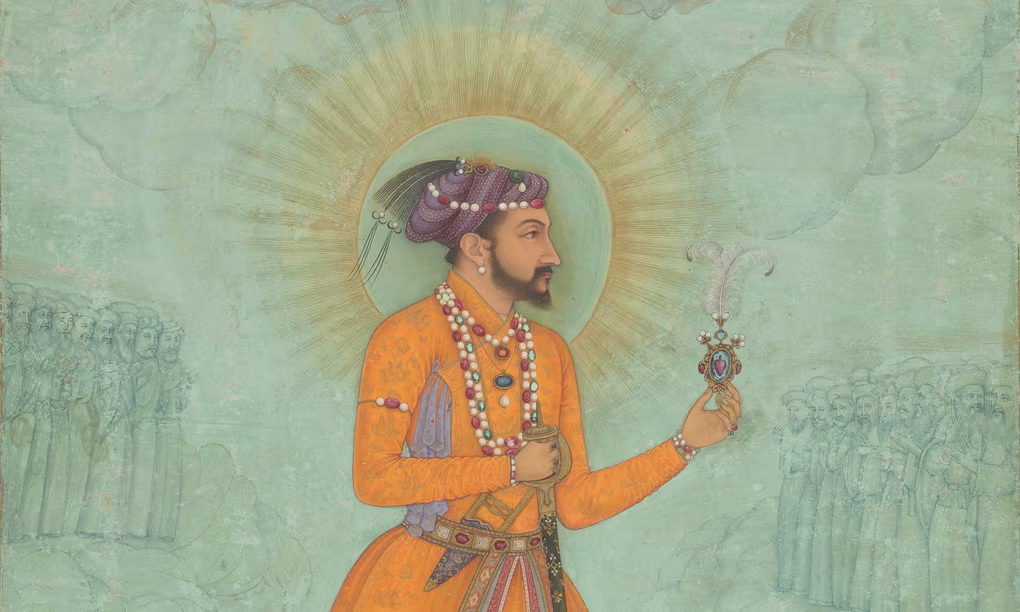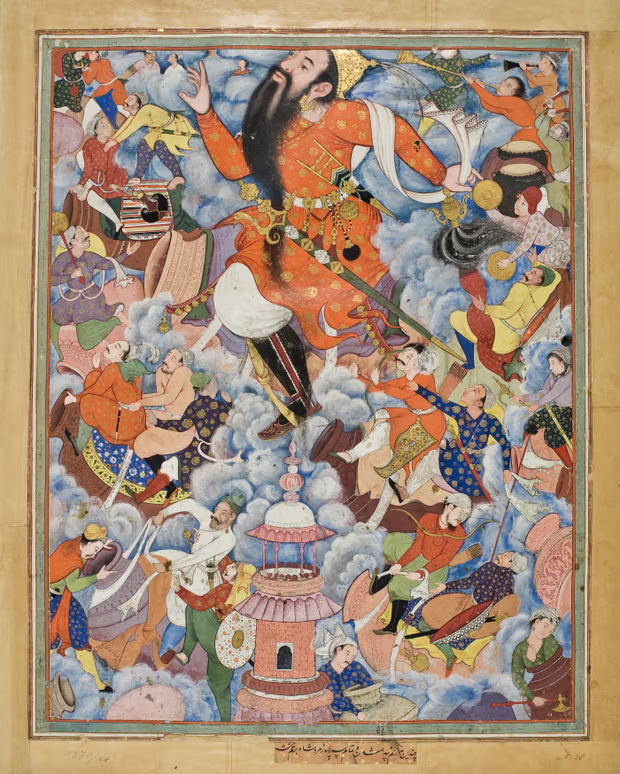INDIA :

Shah Jahan, the fifth Mughal emperor, who built the Taj Mahal to commemorate his favourite wife. Photograph: The Trustees of the Chester Beatty Library, Dublin
V&A, London
Romance, bloodshed and religious curiosity is distilled in these lovely artefacts from the mighty military reign with a love of beauty and culture
This exhibition wafts you to the paradise that Shah Jahan, fifth of the Muslim emperors of much of modern India and Pakistan, wanted to create on Earth. A floor-covering decorated with red poppies sets the scene for this idyll of calmness. A rippled stone panel with myriad water spouts had me dreaming of fruit trees and pavilions while I was cooled by a stone jali screen that once filtered air through one of his buildings. These lovely objects help to fill in for his masterpiece, which for obvious reasons can’t be here: the Taj Mahal.
It is shown on a big screen above the portable delights, twinkling white in the hazy Agra sky. Shah Jahan famously built it as a mausoleum for his favourite wife, Mumtaz Mahal, who died in childbirth in 1631; his tomb is there beside hers. It may be familiar but this piece of architectural heaven captivatingly distils the extraordinary civilisation that a warlike dynasty from Central Asia bequeathed to the world.
The original founder of Mughal power led his armies from Kabul into northern India. When this first empire collapsed it was resurrected by Akbar, first of the exhibition’s “great” Mughal rulers, who combined military might with a love of culture and beauty that his successors would share.

The giant Zumurrud Shah flees with his army, from the Hamzanama, circa 1562-1577. Photograph: MAK/Georg Mayer
Akbar was illiterate but that didn’t stop him employing Hindu and Muslim artists to create a library of illuminated manuscripts. He had readers to tell him what the words said; anyway you can follow the epics he favoured from the ravishing illustrations. In a scene from one of his favourite story cycles, the Hamzanama, a giant with a long beard and bright red coat is chased away through the clouds by Hamza’s army.
The court painting style started by Akbar combines closely observed reality with transporting fantasy. A princess of Kabul lowers her hair for a lover to climb up against a brilliantly realistic garden where ducks swim in a rectangular pool, while above rises a dreamlike mountain landscape and a palace floating in the sky.
In the reign of Akbar’s successor, Jahangir, who came to the throne a couple of years after James I was crowned in England, a natural historical and scientific curiosity sharpens the paintings. In about 1612, a North American turkey cock reached the court and the renowned artist Mansur painted it. The bird – with its orange head, long drooping beak and fan tail – seems to pose as patiently for its portrait as Jahangir himself does in a painting of him studying a globe.
The Great Mughals were interested not just in globes but the globe. They embraced religious complexity and did not expect the Hindu population to convert to Islam. In fact, these curious rulers were attracted to Hindu mythology and mystics. In a painting entitled A Muslim Pilgrim Learns a Lesson in Piety from a Brahman, the pilgrim walks through a rolling north Indian landscape where he encounters a Hindu mystic lying in the road in true spiritual humility. The Mughals were also attracted to the mystic Islamic Sufi movement. That is represented here by a Sufi dervish’s drinking horn and Sufi-inscribed tiles from a now-vanished mosque in Lahore.
Their art absorbed influences from Persia to Renaissance Europe. Portuguese merchants are depicted visiting the Mughal court and, more mysteriously, speaking with angels as the court artists try to make sense of their strange Christian religion.
The exchange went both ways. A Mughal round shield, covered in lustrous mother of pearl patterns and pictures, has been lent by the Bargello Museum in Florence. This dazzling luxury object entered the collection of the Medici family in the 1590s.
This shield never saw battle, plainly, but the Mughals didn’t create their gorgeous world without bloodshed. Many weapons here are opulent and lethal: curved daggers with jewel-encrusted hilts and scabbards, “punch daggers” with floral decoration.
Art itself could be a fantasy of killing. There’s a portrait of Jahangir standing on a globe, shooting an arrow at close range at the severed head of his enemy Malik Ambar. This never happened, but the painting may have eased the emperor’s desire for revenge against this formerly enslaved Ethiopian who rose to be regent of a sultanate and a thorn in Jahangir’s flesh.
When the battles are won and the day’s hunting is over, you drink wine from a jade cup poured from a slender-necked ewer and walk in the gardens to be soothed by the pitter patter of fountains. Where is paradise? A Mughal court poet offered an answer you might agree with by the end of this show: “It is here, it is here, it is here.”
source: http://www.theguardian.com / The Guardian / Home> Art> Review / by Jonathan Jones / November 06th, 2024








